On March 31, the government working group that has been examining the projected damage scale of a potential Nankai Trough megaquake released an estimate report indicating that up to 298,000 people could die, with economic damages reaching 292 trillion yen. In addition to direct fatalities, over 50,000 people could die from disaster-related causes, and 764 municipalities across 31 prefectures—where approximately 50% of the population resides—could experience strong shaking of seismic intensity of at least 6-lower, or tsunamis exceeding three meters in height.
The previous estimate from 2012 projected 323,000 deaths. There were hopes that disaster prevention and mitigation measures implemented over the subsequent 12+ years would significantly reduce the projected death toll, but the decrease was less than 10%. The new damage projections reveal impacts that would certainly shake the nation to its core and inflict serious damage to its socioeconomic structure.
However, these figures reflect analysis based on current countermeasures, and it is entirely possible to reduce casualties, even by a single person, and damage by a small amount through nationwide disaster prevention and mitigation efforts going forward. The government and relevant local authorities urgently need to drastically revise evacuation measures and infrastructure development, while communities and individuals must enhance and thoroughly implement preparedness measures with even greater vigilance than before.
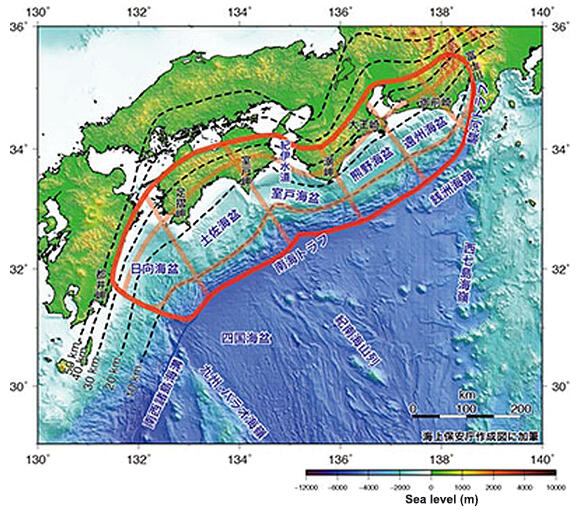
Provided by the government's Headquarters for Earthquake Research Promotion/Earthquake Research Committee
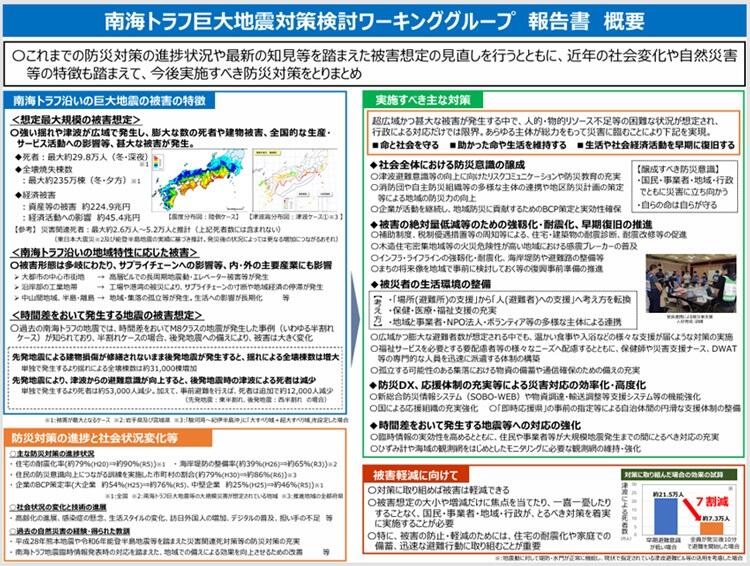
Provided by the Cabinet Office
"Almost 10% Reduction" Falls Far Short of "80% Death Reduction" Goal
Nankai Trough megaquakes occur along a trough-shaped topography (a submarine trench) extending from Suruga Bay off Shizuoka Prefecture to the Hyuganada Sea off Kyushu, and have hit at intervals of approximately 100-150 years in the past. In January this year, the government's Earthquake Research Committee revised the probability of a magnitude (M) 8-9 earthquake occurring within the next 30 years due to the passage of time, raising it from the previous "70-80%" to "about 80%."
In response to the damage projections published in August 2012, the government formulated the "Basic Plan for Promoting Nankai Trough Earthquake Disaster Prevention Measures" in March 2014. Setting goals such as "reducing the number of deaths by approximately 80%," it designated 707 municipalities across 29 prefectures as "Nankai Trough Earthquake Disaster Prevention Measures Promotion Areas" and advanced various disaster prevention and mitigation measures.
A working group established within the Cabinet Office (the Nankai Trough Megaquake Countermeasures Working Group, chaired by Professor Emeritus Nobuo Fukuwa of Nagoya University) began incorporating data on the progress of disaster prevention and mitigation measures, the latest calculation models, and research findings on ground conditions and tsunamis in April 2023. Subsequently, they also factored in data from the Noto Peninsula Earthquake to develop new damage projections.
The newly released damage projection indicates 298,000 potential deaths. Of these, tsunami casualties account for 215,000. Huge tsunamis exceeding 10 meters are projected to strike 13 prefectures from the Kanto region to Kyushu. Although the new projections reflect higher-precision topographical data, areas expected to be flooded to a depth of 30 centimeters or more increased by 30% compared to the previous projection.
As a result, even when considering the effects of certain improvements like seawalls and tsunami evacuation facilities, the number of casualties was not significantly reduced. Additionally, 73,000 deaths are projected to result from building collapses.
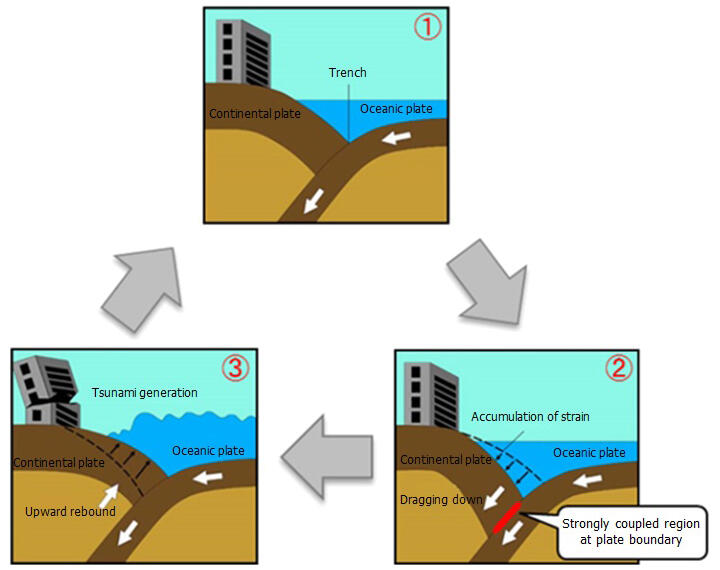
Provided by the Japan Meteorological Agency

Provided by the Japan National Press Club
The Worst-Case Scenario is a Late-Night Quake in Winter, But Early Evacuation Can Reduce Casualties
The new damage projection work analyzed and evaluated earthquake motion and tsunamis in detail based on various data across multiple scenarios, accounting for differences in how earthquakes occur. The resulting report spans approximately 100 pages. The maximum number of casualties would occur in a scenario where a magnitude 9 earthquake strikes late on a winter night with wind speeds of 8 meters per second, causing significant damage in the Tokai region that would also heavily impact the Tokyo metropolitan area. In this scenario, the prefecture-by-prefecture death toll would be highest in Shizuoka Prefecture at 101,000 people, followed by Miyazaki Prefecture at 33,000 people, and Mie Prefecture at 29,000 people.
The projected tsunami death toll of 215,000 is estimated based on the assumption that only 20% of people can evacuate immediately. If the percentage of people able to evacuate increases to 70%, casualties could be significantly reduced to 94,000. This once again demonstrates how crucial prompt evacuation is for saving lives.
The projection indicates that shaking of seismic intensity 7 will strike 149 municipalities across 10 prefectures from Shizuoka to Miyazaki Prefecture, while an area experiencing at least seismic intensity 6-lower will extend to 600 municipalities across 24 prefectures from Kanagawa to Kagoshima Prefecture. Tsunamis of three meters or higher will reach a wide area from Fukushima to Okinawa Prefecture, with a maximum height of 34 meters projected for Kuroshio Town and Tosashimizu City in Kochi Prefecture. In places like Shizuoka City and Kushimoto Town in Wakayama Prefecture, tsunamis of one meter or higher could arrive in as little as two minutes. This indicates that rapid evacuation may not be easy depending on the location.
The number of evacuees after the earthquake has increased from 9.5 million in the previous estimate to 12.3 million (one week after the earthquake), representing about 10% of the total population. Additionally, the number of completely destroyed or burnt buildings has slightly decreased from 2,386,000 to 2,350,000 due to earthquake-resistance improvements in housing. However, this figure is still extremely high, indicating that countermeasures have not been sufficiently effective.
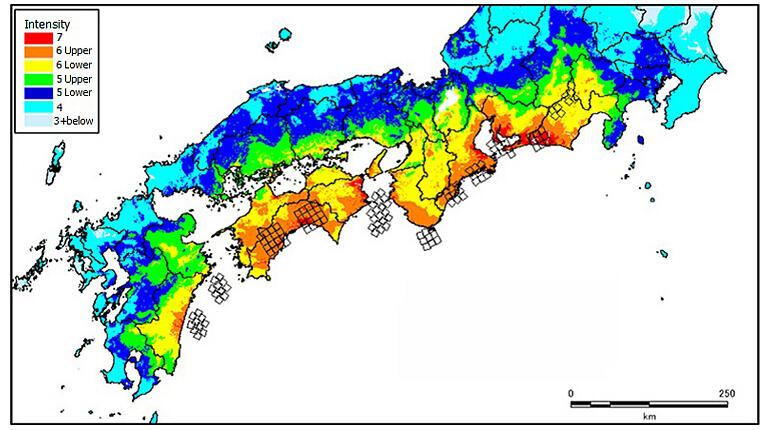
Provided by the Cabinet Office.
First-ever related death estimate exceeds 50,000 at maximum
The 298,000 deaths represent direct deaths from tsunamis and building collapses. For the first time, the report also separately calculated disaster-related deaths resulting from deteriorating health and other factors while living in evacuation shelters, based on the number of evacuees from major past earthquakes and related death situations from the Great East Japan Earthquake and the Noto Peninsula Earthquake. However, the figure was given a range of 26,000 to 52,000 people, acknowledging limitations in estimation accuracy. The 52,000 figure is more than 13 times the number of related deaths from the Great East Japan Earthquake.
The damage from a Nankai Trough megaquake could be on a scale and to a geographic extent unprecedented in modern society. Furthermore, there is concern that disaster-related deaths could increase even further if adverse conditions accumulate, such as insufficient external assistance.
In the Kumamoto Earthquake and Noto Peninsula Earthquake, disaster-related deaths exceeded direct deaths from building collapses, leaving a significant and serious challenge. In December last year, the government revised its evacuation shelter operation guidelines, encouraging local governments to incorporate international standards for improving the secured area per person and number of toilets at evacuation sites.
However, the extent to which local governments nationwide have implemented these measures remains unclear. To reduce the estimated number of disaster-related deaths even slightly, urgent measures centered on improving the environment of evacuation shelters and temporary housing are needed.
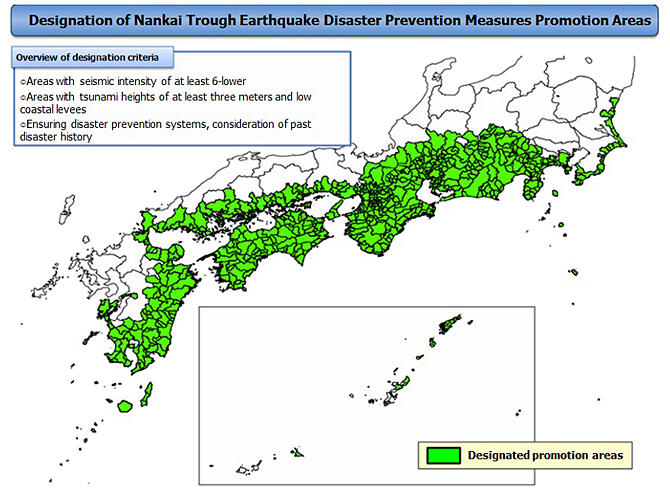
Provided by the Cabinet Office
Economic damage amount approaches nearly half of nominal GDP
The economic damage is now estimated at a maximum of 224.9 trillion yen in direct damage (for restoring buildings and facilities), increasing to 270.3 trillion yen when including the impact of reduced production capacity due to business damage, an increase from the 214.2 trillion yen indicated in 2013. When the impact of damage to transportation infrastructure is added to the new economic damage amount, it reaches 292 trillion yen. This is equivalent to nearly half of the nominal GDP (Gross Domestic Product) of 609 trillion yen for fiscal year 2024. The increase from the previous estimated economic damage is attributed to factors such as calculated increases in recovery costs due to steeply rising material prices.
The breakdown of the estimated economic damage includes damage to buildings, including office buildings and apartments, and infrastructure (224.9 trillion yen), as well as 3.4 trillion yen for sewage systems, 800 billion yen for water supplies, and 100 billion yen for electricity in the lifeline sector. The shutdown of such critical infrastructure would severely restrict daily life, with an estimated maximum of 36.9 million people losing access to water supplies and 35.7 million people unable to use sewage systems. Power outages would affect up to 29.5 million households. It is certain that most mobile phone calls would be impossible immediately after the earthquake.
Damage related to decreased production and services amounts to 45.4 trillion yen. Particularly large losses would occur in manufacturing and retail industries concentrated in the Pacific coastal areas facing the Nankai Trough, with effects extending nationwide. The impacts are expected to last for an extended period, including business bankruptcies, collapse of manufacturing supply chains, and increased unemployment due to business failures.
Transportation system damage would also be enormous, with projected damage at 43,200 locations for roads and 18,700 locations for railways. The Tomei Expressway would certainly be closed, and the Tokaido and Sanyo Shinkansen bullet train lines would likely be out of service for extended periods. Additionally, airports within the projected damage area, including Chubu Centrair International Airport and Kansai International Airport, would suffer tsunami flooding damage and require time for recovery.
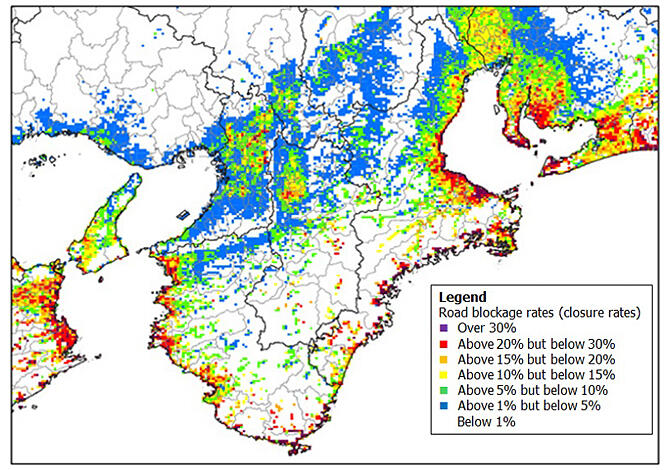
Provided by the Cabinet Office
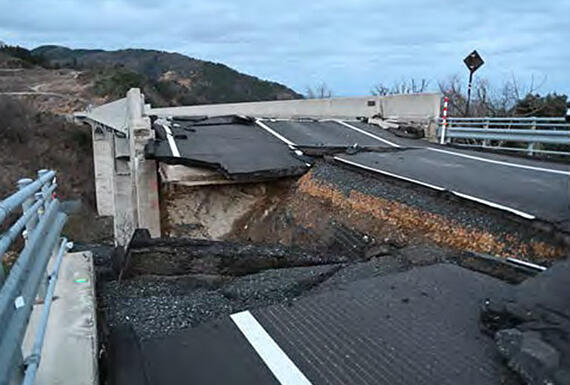
Provided by the Japan Academic Network for Disaster Reduction /Yoshikazu Takahashi
Earthquake resistance rate improves, but densely built-up areas are still dangerous
The Basic Plan for Promoting Nankai Trough Earthquake Disaster Prevention Measures set goals to reduce deaths by 80% and the number of completely destroyed buildings by 50% over 10 years. However, there are notable shortfalls in areas necessary for achieving these goals, such as earthquake resistance rates and measures for densely built-up urban areas.
According to the Ministry of Land, Infrastructure, Transport and Tourism, the earthquake resistance rate of houses nationwide has significantly improved from 79% in 2008 to 90% in 2023. However, as revealed by the Noto Peninsula Earthquake, earthquake resistance improvements in mountainous areas and depopulating regions are lagging. The original goal to "largely eliminate houses with insufficient earthquake resistance by 2025" is behind schedule, and the achievement date has been postponed to 2030.
Many depopulating regions have aging populations, making rebuilding difficult, and many households lack the financial resources for even partial seismic reinforcement. The reality is that public subsidies centered on local governments also have limitations. For this reason, many experts point out that enhancement of national-level subsidy programs is necessary to improve earthquake resistance rates.
In addition to strengthening buildings, measures to secure furniture to reduce crushing deaths and injuries remain a challenge, with implementation at only 36% as of 2022, still a low level. Furthermore, measures to eliminate densely built-up urban areas at risk of expanding fire damage have not progressed sufficiently, reaching only 61% as of March 2024.
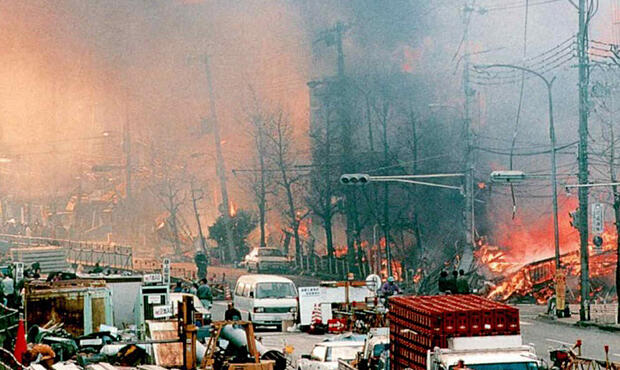
Provided by Kobe City
National Resilience Plan also fails to significantly reduce projected damage
The projected death toll of "323,000 people" from a Nankai Trough megaquake announced in 2012 sent major shockwaves through society at that time. In the previous year's Great East Japan Earthquake, nearly 20,000 people had already died or gone missing shortly after the disaster occurred.
At that time, to utilize the lessons from this tragedy, the government established the "Basic Act for National Resilience" in 2013. The following year, in June 2014, it formulated the "National Resilience Plan," significantly shifting the national disaster prevention approach from post-disaster recovery to pre-disaster preparedness. The initiatives covered a wide range of measures, including strengthening seawalls and levees, developing evacuation facilities and routes, improving building earthquake resistance rates, seismically reinforcing roads and bridges, sharing hazard maps, and conducting disaster drills in cooperation with local governments.
Given all this, there were expectations from not only the national government but also from private sectors, local governments, and many other quarters that the new damage projections released more than 10 years after the previous estimate would show significantly reduced death tolls and economic damage as a result of subsequent countermeasure progress. However, the projected death toll decreased by only about 8%—not even reaching a 10% reduction from the previous estimate—showing little significant change, while the economic damage amount actually increased.
The process of producing the new damage projections, based on meticulous analysis of numerous data points, has ruthlessly demonstrated both the terrifying nature of a megaquake and the difficulty of implementing specific disaster mitigation measures to protect lives.
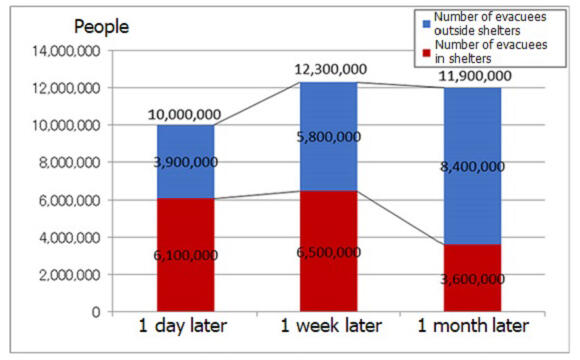
Provided by the Cabinet Office
No time to waste in strengthening countermeasures
In response to this damage projection report, the government plans to revise the Basic Plan for Promoting Nankai Trough Earthquake Disaster Prevention Measures as soon as possible to further strengthen pre-disaster countermeasures. Additionally, considering the expanded projected flooding areas, it will designate additional areas as promotion regions for countermeasures. Furthermore, the government intends to revise the current National Resilience Plan.
The government plans to establish a new Disaster Prevention Agency in fiscal year 2026. However, what is needed is not only simple strengthened coordination among disaster prevention-related ministries and agencies, but also the rapid implementation of highly effective policies.
While the probability of a Nankai Trough megaquake occurring within the next 30 years is currently set at about 80%, it has been repeatedly pointed out that it is incorrect to divide 80% by 30 to calculate the probability of occurrence in the next year. It might not happen even after 30 years, or it could happen today or tomorrow. Although psychology tells us it's natural for many people to have a "normalcy bias" thinking "it will probably be fine," living in this earthquake-prone country means there's no overreaction in maintaining a strong sense of crisis. There's "no time to waste" in strengthening countermeasures nationwide.
Last August, a magnitude 7.1 earthquake occurred off the coast of Miyazaki Prefecture, located at the western end of the projected source region, when part of the plate boundary shifted. As the possibility of a megaquake had increased above normal levels, the Japan Meteorological Agency issued its first "Nankai Trough Earthquake Extraordinary Information (Megaquake Advisory)," calling for reconfirmation of preparedness measures for one week.
During this period, fortunately, no major earthquake occurred, but Naoshi Hirata, Chairman of the government's Earthquake Research Committee (Professor Emeritus at the University of Tokyo), warns that "Extraordinary information is not necessarily issued before a megaquake. There is a high possibility that a megaquake will suddenly occur without any precursors."
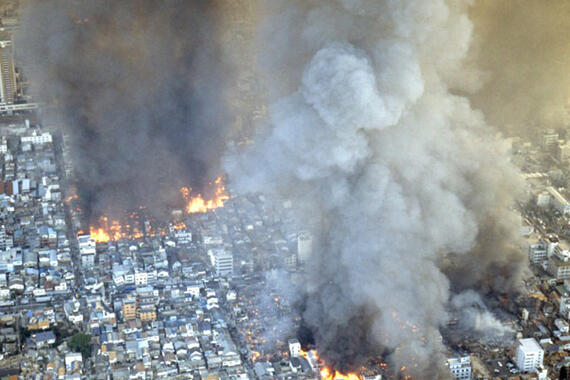
Provided by Kobe City
Preparedness to save as many lives as possible
At a press conference following the release of the new damage projections, Chief Cabinet Secretary Yoshimasa Hayashi stated, "We will take (the published) contents seriously to heart and strengthen efforts for building earthquake resistance, disaster prevention facilities, and early evacuation awareness," clarifying the government's policy to further enhance countermeasures.
At the press conference, Professor Fukuwa, who chaired the government working group that compiled these damage projections, expressed his sense of crisis: "Unless we reduce the (projected) damage, the future of the nation is at risk." In a press conference at the Japan National Press Club last August, he emphasized, "The key to damage reduction lies in advance countermeasures, and their success depends on changing public awareness. Without relying solely on the national government or administration, local governments, individuals, businesses, and industries must work together and come up with ideas to raise disaster prevention awareness."
March 11 marked 15 years since the occurrence of the Great East Japan Earthquake. Including disaster-related deaths, more than 22,000 precious, irreplaceable lives were lost or went missing. Many times that number—tens of times higher, or even more—continue to live forward-facing lives while still carrying their grief.
Considering this, a figure like "up to 298,000 deaths" must absolutely never become reality. If a megaquake is inevitably coming someday, there are many things that can and should be done to prepare and protect as many lives as possible.
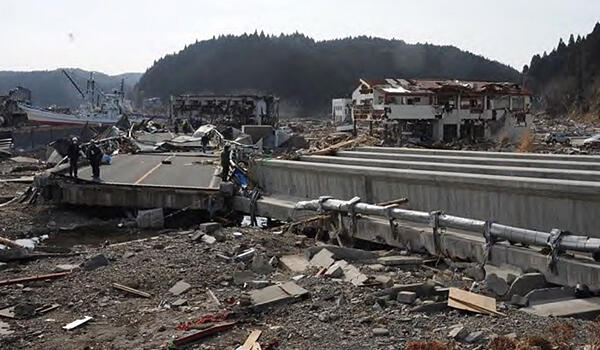
Provided by the Japan Academic Network for Disaster Reduction /Yoshikazu Takahashi
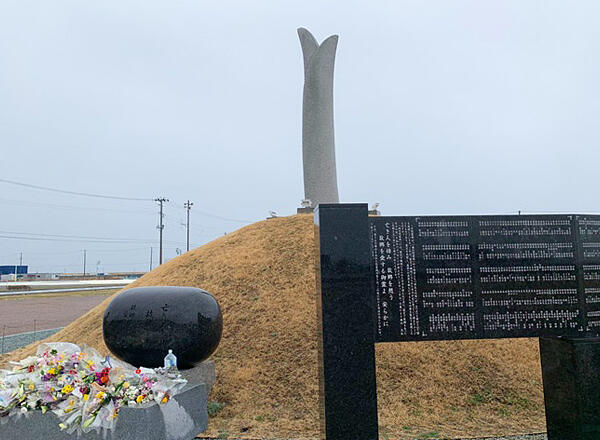
(Photographed March 13, 2023)
(UCHIJO Yoshitaka / Science Journalist, Kyodo News Visiting Editorial Writer)
Original article was provided by the Science Portal and has been translated by Science Japan.




